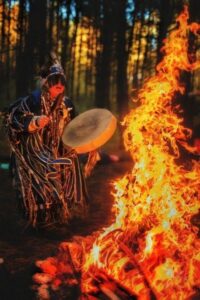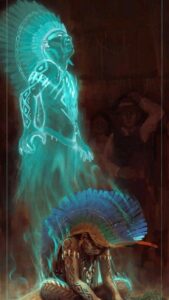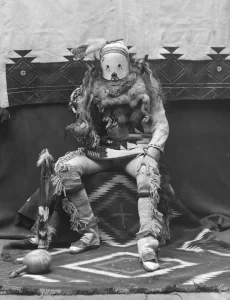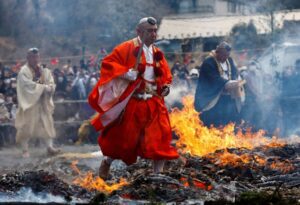The Essence of Shamanism

Shamanism embodies the belief in a deeply interconnected universe, where every element of nature holds spiritual significance. This ancient practice is found in cultures across the globe. Similarly suggests that the physical world we perceive is just the surface of a deeper, spiritual reality. The origins of shamanism trace back to the hunter-gatherer societies. Yeah, that old! Back then, shamans served as the mediators between the physical and spiritual worlds, guardians of ancient knowledge and healing practices. Some kind of an Avatar, you may say.
The Shaman: A Conduit of the Spirit World

What, then, does a shaman do exactly? Shamans embark on ecstatic spiritual journeys, entering altered states of consciousness to communicate with spirits, seek guidance, or heal ailments. They wield the sacred knowledge of plants, stones, and animal spirits, employing rituals and ceremonies to maintain a balance between the human community and the natural world. The role of a shaman encompasses that of a healer, guide, and protector, navigating the spiritual realm to restore harmony and well-being.
Powers Beyond the Physical Realm
The powers of a shaman are as diverse as the cultures from which they emerge. Yet, most of them share the same root. Like, “Magical Fire” and “Mastery Over Fire”. Mastery over fire gives practitioners the power to remain unaffected by hot coals. Examples of this can be found almost everywhere in the shamanic world. As preparation for trance, shamans may play with burning coals, swallow them, or hold red-hot iron with their bare hands. Throughout all of Northern Asia, shamans can cut their bodies and swallow burning coals, holding hot or cold iron with their bare hands. The same practices are found among North American shamans. For example, among the Zuni, shamans do all sorts of things with fire.

Dominion over fire is definitely an archaic ritual. It is not only pre-Christian but perhaps even predates Indo-European times. This and similar “miraculous powers” indicate that the shaman has reached a well-known condition based on ecstasy. It seems to indicate that by purifying from the physical, one has reached a state of absolute spiritual freedom. Powers such as mastery over fire or immunity to extreme cold are material expressions of the idea that the shaman has transcended human existence and merged with the “spirits.” During this ecstasy, the shaman reaches the spiritual dimension and receives information needed.
The Path of the Shaman: A Calling of the Soul
Becoming a shaman is not a choice but a calling, often revealed through profound dreams, visions, or life-changing experiences. This path mostly demands dedication, wisdom, and painful experiences, mostly. Shamans undergo rigorous training, learning to control their minds. Gain incredible powers to achieve that euphoric moment.
One of the endurance tests of shamanism demands a capacity to withstand extreme cold as much as extreme heat. For instance, among the Manchurians, a prospective shaman must undergo the following test. The candidate must enter the water through one of nine holes made in the ice during winter. Swim under the ice, then exit through another hole and enter the next one. The test continues until all nine holes are completed.

There are even some Hindu-Tibetan tests that examine a shaman candidate’s ability to dry wet cloths on their naked body. Under the falling snow in winter! In Tibetan, this is called “spiritual fire” (gtum-mo, pronounced tumo). The cloths are dipped in ice-cold water. The candidates must wrap one of the cloths around their body and dry it with their body heat. As soon as the cloth dries, it is dipped in water again and wrapped around the candidate’s body to be dried. This process continues until dawn. The one who dries the most cloths completes the test (1).
The Shaman and Supernatural Powers
We will now touch upon a very important issue: the reality of the extrasensory skills and supernatural powers attributed to shamans and wizard healers. Although research on this matter is very deep, there is already a significant amount of ethnographic documentation that dispels the clouds of doubt over the authenticity of such phenomena. Ernesto de Martino, an ethnologist who is also a philosopher, critically examined the testimony related to extrasensory perception by explorers and concluded that they were real.
Among the best-observed cases are the powers of the Tonga shamans described by Shirokogorov, which include seeing the future and reading thoughts. There have been some strange cases based on dream-based foresight among the Pygmies, with very concrete examples related to the outcomes of these cases observed. Similarly, there are examples among the Pygmies related to understanding unknown languages, and among the Zulus, examples related to seeing the future. W. Bogoraz, who even recorded the “voices of the spirits” of shamans, draws attention to many other supernatural phenomena among the Chukchi. These voices recorded by Bogoraz were previously explained by ventriloquism. However, this now seems unlikely, as it is clear that the voices come from a source far in front of the recording device, beyond the shaman (1).
Referances:
- Eliade, Mircea. Shamanism: Archaic Techniques of Ecstasy. Princeton University Press, 1964.
- Singh, Manvir. “The Cultural Evolution of Shamanism.” Behavioral and Brain Sciences, vol. 41, 2018, e66.
- Lewis-Williams, David. The Mind in the Cave: Consciousness and the Origins of Art. Thames & Hudson, 2002.
- Hoppál, Mihály. Siberian Shamanism: The Shamanic World of Siberia and Central Asia. International Society for Shamanistic Research, 2005.
- Vitebsky, Piers. The Shaman: Voyages of the Soul – Trance, Ecstasy and Healing from Siberia to the Amazon. Duncan Baird Publishers, 1995.
- Kehoe, Alice B. Shamans and Religion: An Anthropological Exploration in Critical Thinking. Waveland Press, 2000.Hutton, Ronald. Shamans: Siberian Spirituality and the Western Imagination. Hambledon and London, 2001.


